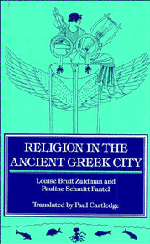Book contents
- Frontmatter
- Contents
- List of illustrations
- Author's preface to the English translation
- Translator's introduction
- List of sources
- PART I Introduction: How should we study Greek civic religion?
- PART II Cult-practices
- 4 Rituals
- 5 Religious personnel
- 6 Places of cult
- 7 Rites of passage
- 8 Settings of religious life
- 9 Religion and political life
- 10 The festival system: the Athenian case
- 11 The Panhellenic cults
- PART III Systems for representing the divine
- PART IV Envoi
- Appendixes
- Bibliography
- Index
6 - Places of cult
Published online by Cambridge University Press: 05 June 2012
- Frontmatter
- Contents
- List of illustrations
- Author's preface to the English translation
- Translator's introduction
- List of sources
- PART I Introduction: How should we study Greek civic religion?
- PART II Cult-practices
- 4 Rituals
- 5 Religious personnel
- 6 Places of cult
- 7 Rites of passage
- 8 Settings of religious life
- 9 Religion and political life
- 10 The festival system: the Athenian case
- 11 The Panhellenic cults
- PART III Systems for representing the divine
- PART IV Envoi
- Appendixes
- Bibliography
- Index
Summary
SPIRIT OF PLACE
For the Greeks any location might serve as a place of cult, a sacred space (hieron). It was enough for it to be perceived as having a sacred character, either because of some special geographical or numinous quality (the majesty of the terrain, as at Delphi; the presence of a revered tomb) or because it contained some particular manifestation of the divine – rocks, or a tree, or a spring, for instance. Terrain that was deemed to be sacred was delimited as a temenos or ‘cut-off’ space, separated, that is, from its non-sacred surroundings. Its boundaries could be marked by pillars (horoi) or by a continuous boundary wall (peribolos). Numerous Greek sanctuaries were just such simple enclosures, containing perhaps a sacred wood, a spring, a grotto, or some other natural feature, but no permanent man-made structures. A temenos could harbour the cults of several different gods or be devoted to just one divinity.
The Agora of Athens (see fig. 4) is a good, if unusually well attested and cluttered, example of a temenos. It was a large area to the north of the Akropolis, delimited by inscribed pillars that proclaimed ‘I am a horos (boundary-marker) of the Agora’. Here were situated a host of religious cults, funerary, heroic and divine, each with its appropriate monuments (altars and small shrines for Demeter, Zeus Phratrios, Athene Phratria, and Apollo Patrōos, the enclosure of the Eponymous Heroes, and so on and so forth).
- Type
- Chapter
- Information
- Religion in the Ancient Greek City , pp. 55 - 62Publisher: Cambridge University PressPrint publication year: 1992



